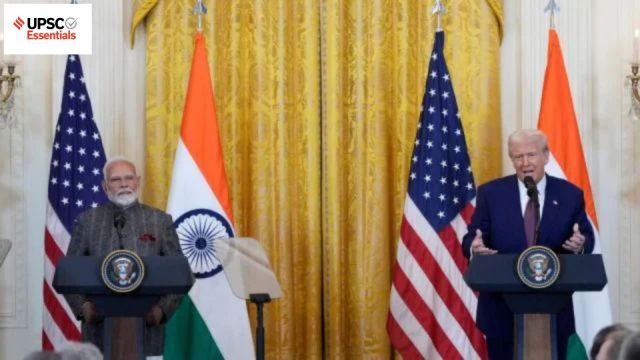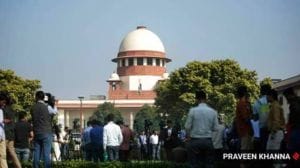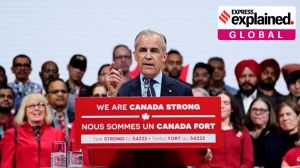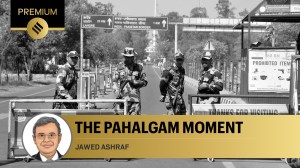UPSC Essentials | Mains answer practice — GS 2: Questions on reciprocal tariffs and withdrawal of transhipment facility granted to Bangladesh (Week 98)
Are you preparing for UPSC CSE 2025? Here are questions from GS paper 2 for this week with essential points as the fodder for your answers. Do not miss points to ponder and answer in the comment box below.
 Attempt a question on the temporary suspension of reciprocal tariffs in today's answer writing practice. (AP Photo)
Attempt a question on the temporary suspension of reciprocal tariffs in today's answer writing practice. (AP Photo)UPSC Essentials brings to you its initiative for the practice of Mains answer writing. It covers essential topics of static and dynamic parts of the UPSC Civil Services syllabus covered under various GS papers. This answer-writing practice is designed to help you as a value addition to your UPSC CSE Mains. Attempt today’s answer writing on questions related to topics of GS-2 to check your progress.
🚨 Click Here to read the UPSC Essentials magazine for March 2025. Share your views and suggestions in the comment box or at manas.srivastava@indianexpress.com🚨
QUESTION 1
During the US administration’s temporary suspension of reciprocal tariffs, India is actively pursuing the completion of an interim trade agreement with the US. Discuss the strategic importance of this endeavour in India’s trade policy.
QUESTION 2
India’s decision to withdraw the transhipment facility granted to Bangladesh during the COVID-19 pandemic has far-reaching consequences for bilateral relations. Discuss.
General points on the structure of the answers
Introduction
— The introduction of the answer is essential and should be restricted to 3-5 lines. Remember, a one-liner is not a standard introduction.
— It may consist of basic information by giving some definitions from the trusted source and authentic facts.
Body
— It is the central part of the answer and one should understand the demand of the question to provide rich content.
— The answer must be preferably written as a mix of points and short paragraphs rather than using long paragraphs or just points.
— Using facts from authentic government sources makes your answer more comprehensive. Analysis is important based on the demand of the question, but do not over analyse.
— Underlining keywords gives you an edge over other candidates and enhances presentation of the answer.
— Using flowcharts/tree-diagram in the answers saves much time and boosts your score. However, it should be used logically and only where it is required.
Way forward/ conclusion
— The ending of the answer should be on a positive note and it should have a forward-looking approach. However, if you feel that an important problem must be highlighted, you may add it in your conclusion. Try not to repeat any point from body or introduction.
— You may use the findings of reports or surveys conducted at national and international levels, quotes etc. in your answers.
Self Evaluation
— It is the most important part of our Mains answer writing practice. UPSC Essentials will provide some guiding points or ideas as a thought process that will help you to evaluate your answers.
THOUGHT PROCESS
You may enrich your answers by some of the following points
QUESTION 1: During the US administration’s temporary suspension of reciprocal tariffs, India is actively pursuing the completion of an interim trade agreement with the US. Discuss the strategic importance of this endeavour in India’s trade policy.
Note: This is not a model answer. It only provides you with thought process which you may incorporate into the answers.
Introduction:
— Following US President Donald Trump’s announcement of a delay on reciprocal tariffs, India hopes to sign an interim trade agreement with the US during the 90-day gap.
— A deal is feasible within 90 days if it benefits both parties. By then, the general contours will have been decided. The Terms of Reference (ToR) have been inked, and India is well ahead of other countries pursuing a deal with the United States.
— Separately, External Affairs Minister S Jaishankar stated that India is attempting to express the importance of concluding trade treaties with the United States, the European Union, and the United Kingdom.
Body:
You may incorporate some of the following points in your answer:
— The Terms of Reference establish the structure of the proposed Bilateral Trade Agreement (BTA) and normally require approval from the highest governmental authority before negotiations can commence. Following an intervention by the Prime Minister’s Office (PMO) to hasten the finalisation of the trade deal’s parameters, India inked a memorandum of understanding with the United States immediately before the reciprocal action.
— On the EU FTA, Commerce Minister Piyush Goyal stated that while there has been progress, problems remain, notably in terms of non-trade issues related to climate legislation. “Europe must review the non-tariff barriers that it has established. These are becoming trade barriers, not just for India, but for the entire world economy.
— India has expressed concern about the EU’s carbon tax, which might have an impact on the country’s steel industry in particular, as well as much of its manufacturing sector. The world cannot be seen via a single lens. While rich nations enjoy wealth, developing and least-developed countries require time and assistance to catch up.
— India stays devoted to multilateralism. WTO reforms are needed. The need to reconsider the definition of “developing countries” and seek clarification on e-commerce regulations, agricultural policies, and fisheries talks.
— With a three-month gap before 26% US reciprocal tariffs take effect, India is eager to finalise an interim trade agreement. The Terms of Reference for a bilateral trade agreement have already been inked, and India believes that a win-win interim deal may be reached within 90 days.
Conclusion:
— The Indian and US trade teams are currently discussing the expedited conclusion of a mutually advantageous, multi-sectoral bilateral trade agreement. India values its comprehensive global strategic cooperation with the United States and is dedicated to working closely with it.
— Following negotiations between Prime Minister Narendra Modi and Trump in Washington, DC in February, the two sides agreed to conclude the first tranche of the Bilateral Trade Agreement by the autumn of 2025.
(Source: India keen on interim trade deal with US in pause period by Ravi Dutta Mishra and Shubhajit Roy)
Points to Ponder
India-US trade ties
Read about World Trade Organisation
Read more about EU’s carbon tax
Related Previous Year Questions
‘Indian diaspora has a decisive role to play in the politics and economy of America and European Countries’. Comment with examples. (2020)
What is the significance of Indo-US defence deals over Indo-Russian defence deals? Discuss with reference to stability in the Indo-Pacific region. (2020)
QUESTION 2: India’s decision to withdraw the transhipment facility granted to Bangladesh during the COVID-19 pandemic has far-reaching consequences for bilateral relations. Discuss.
Note: This is not a model answer. It only provides you with thought process which you may incorporate into the answers.
Introduction:
— India recently revoked Bangladesh’s ability to use Indian ports and airports for third-country exports, despite an agreement reached in 2020.
— India offered this facility to Bangladesh at a time when the entire South Asian region was severely hit by Covid-19. Bangladesh was also decimated by the pandemic, and the country’s textile makers were receiving orders for health equipment such as masks, medical fabric, and hand gloves, among other things. Due to air and shipping limitations, Bangladesh approached India. This was the beginning of the voyage, which has since proven to be short-lived.
Body:
You may incorporate some of the following points in your answer:
— India enabled Bangladesh to tranship export cargo through its Land Customs Stations (LCSs) and Integrated Check Posts (ICPs). This was a humanitarian gesture aimed at assisting Bangladesh in meeting increased export requests for ready-made clothing.
— India’s ports and airports boosted Bangladesh’s confidence amid the catastrophic pandemic. The land border, particularly the major Petrapole-Benapole border, continued to operate normally.
— Bangladesh was one of the few countries that saw increased global exports, particularly RMG, during the epidemic. Bangladesh’s exports in 2019-20 was $33.67 billion, with RMG exports accounting for $27.95 billion. In 2020-21, Bangladesh’s global exports climbed to $38.79 billion, with RMG exports increasing to $31.46 billion. The pattern persisted subsequently. In 2021-22, this sum soared to $52.08 billion, with RMG exports accounting for $42.61 billion, a staggering 35% increase.
— Bangladesh has over 35 years of textile manufacturing experience and currently services all major global fashion brands from its over 4,000 factories. The Dhaka-Delhi multi-modal transport route gave Bangladesh a substantial edge in fulfilling global orders at a lesser cost and with timely deliveries.
— Sportswear heavyweights like Decathlon, as well as global apparel companies like Zara, H&M, and Gucci, leveraged the Dhaka-Delhi trade route to meet international demand. Japanese retail giants like UNIQLO, as well as India’s Reliance and Aditya Birla Group, employ the same technique to import Bangladeshi cotton garments. This agreement, therefore, was a significant achievement in India-Bangladesh relations.
— India expanded this modern infrastructure to Bangladesh over political opposition. Delhi’s air cargo terminal later established the “Transhipment Excellence Centre” (TEC), which provides seamless and efficient transhipment services for goods. The project created substantial congestion at the shipping terminals. Nonetheless, India offered it free of charge and paid all environmental costs as a gesture of goodwill.
— On April 8, India revoked the 2020 deal, which will have an impact not only on Bangladesh’s third-country trade costs and time, but also on bilateral ties.
— The supply chain interruption takes place against the backdrop of Red Sea disruptions. Attacks on vessels have prompted numerous Indian and Bangladeshi ships to detour around the Cape of Good Hope, increasing travel time and costs.
Conclusion:
— If Bangladesh fails to improve its trade infrastructure and quality, it risks losing its worldwide competitiveness in exports, including not only RMG but also medicines, leather goods, processed foods, and so on.
— Bangladesh requires speedier airports and seaports. Matarbari’s proposed deep sea port will have a cargo terminal in service by 2027. Bangladesh’s options are limited on the silted Bay of Bengal coastline. Bangladesh’s rise to prominence in the developing world necessitates peaceful coexistence with its neighbours. It would be better for Bangladesh to strengthen its regional ties with India and the rest of South and Southeast Asia.
Points to Ponder
India-Bangladesh trade ties
India-Bangladesh – important places in news
India- Bangladesh border
Related Previous Year Questions
“If the last few decades were Asia’s growth story, the next few are expected to be Africa’s.”In the light of this statement, examine India’s influence in Africa in recent years. (2021)
‘India is an age-old friend of Sri Lanka.’ Discuss India’s role in the recent crisis in Sri Lanka in the light of the preceding statement. (2022)
Previous Mains Answer Practice
UPSC Essentials: Mains answer practice — GS 3 (Week 98)
UPSC Essentials: Mains answer practice — GS 3 (Week 97)
UPSC Essentials: Mains answer practice — GS 2 (Week 96)
UPSC Essentials: Mains answer practice — GS 2 (Week 97)
UPSC Essentials: Mains answer practice — GS 1 (Week 97)
UPSC Essentials: Mains answer practice — GS 1 (Week 96)
Subscribe to our UPSC newsletter and stay updated with the news cues from the past week.
Stay updated with the latest UPSC articles by joining our Telegram channel – IndianExpress UPSC Hub, and follow us on Instagram and X.
Must Read
Buzzing Now


Apr 29: Latest News
- 01
- 02
- 03
- 04
- 05
























